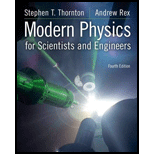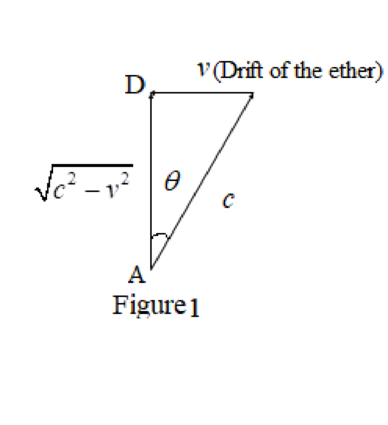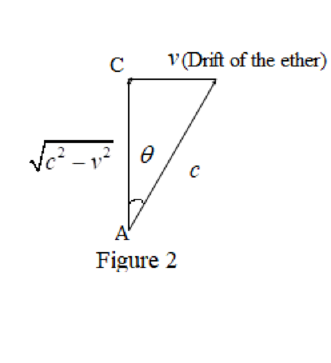
Concept explainers
The time difference after rotating
Answer to Problem 5P
The time difference after rotating
Explanation of Solution
As from figure 2.2, total time (
Where,
As from figure 2.2, total time (
When light travel from A to D, ether will deflect the direction of the light, thus light will not reach to the mirror

Therefore,
Where,
The time difference between two journey before rotating the Michelson interferometer is as follows:
Substituting the values of
After rotating
Therefore, from Galilean transformation velocity of the light along the l2 (from A to D) will be
When light travel from A to C, ether will deflect the direction of the light, thus light will not reach to the mirror
Therefore, by using the vector triangle, the speed of the light will be

Thus, total time taken by light to complete the round-trip journey from A to C is
From equation (IV) and (V) time difference between the two journey is
Conclusion:
Therefore, the time difference after rotating
Want to see more full solutions like this?
Chapter 2 Solutions
Modern Physics for Scientists and Engineers
- Show that a potential difference of 1.02 x 106 V would be sufficient to give an electron a speed equal to twice the speed of light if Newtonian mechanics remained valid at high speeds. (b) What speed would an electron actually acquire in falling through a potential difference equal to 1.02 x 106 V ?arrow_forwardIf a galaxy moving away from the Earth has a speed of 1000 km/s and emits 656 nm light characteristic of hydrogen (the most common element in the universe). (a) What wavelength would we observe on the Earth? (b) Whattype of electromagnetic radiation is this? (c) Why is the speedof the Earth in its orbit negligible here?arrow_forwardcalculate: (a) the real andimaginary part of fı2)= 32-i (b) the real andimaginary part of f(zl=22²-2 c() the abselute va lw of fiz) =z²arrow_forward
- Calculate the range of speeds for a particle of mass m in which the classical relation for the kinetic energy, (1/2)*m*v^2, is within 0.5 percent of the correct relativistic value. Find the values for an electron and a proton.arrow_forwardA galaxy G is moving away radially with speed with respect to an observer O. The relation between X, the wavelength of light emitted at G, and λo, the wavelength observed at O, is 入。 λ = λe λε 1+B 1- B' = where ẞ v/c (c is the speed of light). For ẞ < 1 find a power series expansion of the above formula up to and including terms of order ẞ³.arrow_forwardMichelson and Morley were able to obtain an optical path length l4 + lz of about 22 m. Apparatus had nearly equal arm lengths l = l2 = 1. If 1 = 5.5 × 10-7m and v/c= 10-4, calculate the expected fringe shift for ether to exist. %3Darrow_forward
- Consider two frames S and S, where 5 moves with velocity vî with respect to S'. Consider an electric field (according to S) travelling in the x-direction and polarized in the z-direction given by É(E, t) = E cos(kr – wt)k Solve for its associated magnetic field.arrow_forwardMichelson-Morley Experiment. A shift of one fringe in the Michelson-Morley experiment corresponds to a change in the round-trip travel time along one arm of the interferometer by one period of vibration of light (about 2 X 10-15 s) when the apparatus is rotated by 90. Based on the results of such experiment, what velocity through the ether would be deduced from a shift of one fringe? (Take the length of the interferometer arm to be 11 m.)arrow_forward5.3 A spaceship moves with speed V relative to an observer O, on a straight line which passes very near the observer. A source on the spaceship emits light of wavelength 2o = 500 nm in the frame of reference of the spaceship. For what range of the spaceship's speed will the light be visible to the observer? The wavelengths of visible light stretches from 2A = 400 nm to ig = 700 nm, approximately. Ans.: -0.22 < Bß<0.33arrow_forward
- Muons are unstable subatomic particles that decay to electrons with a mean lifetime of 2.2 µs. They are produced when cosmic rays bombard the upper atmosphere about 10 km above the earth’s surface, and they travel very close to the speed of light. The problem we want to address is why we see any of them at the earth’s surface. (a) What is the greatest distance a muon could travel during its 2.2 µs lifetime? (b) According to your answer in part (a), it would seem that muons could never make it to the ground. But the 2.2 µs lifetime is measured in the frame of the muon, and muons are moving very fast. At a speed of 0.999c, what is the mean lifetime of a muon as measured by an observer at rest on the earth? How far would the muon travel in this time? Does this result explain why we find muons in cosmic rays? (c) From the point of view of the muon, it still lives for only 2.2 µs, so how does it make it to the ground? What is the thickness of the 10 km of atmosphere through which the muon…arrow_forwardThe answer is already shown, I am just confused about the steps. On part a, how does the 3.1447 go to 4.94Re? and then h=3.94Re and then 25097800m? On part b, where does the 2.5 come from? please solve in simpler steps, thank you.arrow_forwardA highway patrol officer uses a device that measures the speed of vehicles by bouncing radar off them and measuring the Doppler shift. The outgoing radar has a frequency of 95 GHz and the returning echo from a truck has a frequency 16.6 kHz higher. How fast in km/h is the truck moving? Note that there are two Doppler shifts in echoes. Be certain not to round off until the end of the problem, because the effect is small. Round your answer to two decimal places.arrow_forward
 College PhysicsPhysicsISBN:9781305952300Author:Raymond A. Serway, Chris VuillePublisher:Cengage Learning
College PhysicsPhysicsISBN:9781305952300Author:Raymond A. Serway, Chris VuillePublisher:Cengage Learning University Physics (14th Edition)PhysicsISBN:9780133969290Author:Hugh D. Young, Roger A. FreedmanPublisher:PEARSON
University Physics (14th Edition)PhysicsISBN:9780133969290Author:Hugh D. Young, Roger A. FreedmanPublisher:PEARSON Introduction To Quantum MechanicsPhysicsISBN:9781107189638Author:Griffiths, David J., Schroeter, Darrell F.Publisher:Cambridge University Press
Introduction To Quantum MechanicsPhysicsISBN:9781107189638Author:Griffiths, David J., Schroeter, Darrell F.Publisher:Cambridge University Press Physics for Scientists and EngineersPhysicsISBN:9781337553278Author:Raymond A. Serway, John W. JewettPublisher:Cengage Learning
Physics for Scientists and EngineersPhysicsISBN:9781337553278Author:Raymond A. Serway, John W. JewettPublisher:Cengage Learning Lecture- Tutorials for Introductory AstronomyPhysicsISBN:9780321820464Author:Edward E. Prather, Tim P. Slater, Jeff P. Adams, Gina BrissendenPublisher:Addison-Wesley
Lecture- Tutorials for Introductory AstronomyPhysicsISBN:9780321820464Author:Edward E. Prather, Tim P. Slater, Jeff P. Adams, Gina BrissendenPublisher:Addison-Wesley College Physics: A Strategic Approach (4th Editio...PhysicsISBN:9780134609034Author:Randall D. Knight (Professor Emeritus), Brian Jones, Stuart FieldPublisher:PEARSON
College Physics: A Strategic Approach (4th Editio...PhysicsISBN:9780134609034Author:Randall D. Knight (Professor Emeritus), Brian Jones, Stuart FieldPublisher:PEARSON





